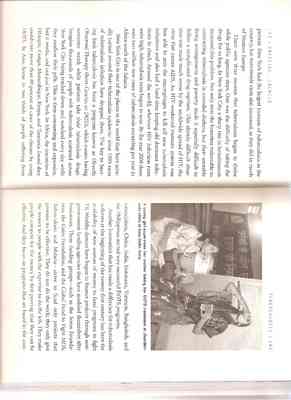Pages
16
OUTLASTING THE DRUGS Soon after streptomycin's glorious discovery, a troubling thing occurred. When some patients took the druge, they felt much better for the first couple of months: they gained weight, and the tuberculosis bugs they coughed up had been killed by the drug. Then, strangely, the drug stopped working, the coughing and weakness returned, and the bugs they coughed up were alive and kicking and no amount of streptomycin could kill them. With no other cure possible, these patients could go on to die, and anyone infected by their hardy germs could not be treated by streptomycin either. It appeared that tuberculosis was learning how to outsmart the drug! Of course, tuberculosis is just a bacterium; it does not have a brain in its tiny rod-shaped body. It cannot learn anything, so how was it getting around streptomycin? The answer is this drug: drug-resistant strains were evolving. A person infected with tuberculosis is like an island nation of TB germs. When assaulted by an antibiotic, all the germs begin to die. However, in this nation, there might be some germs that are just a little different, as there are people in any crowd who are just a little different. These germs might be different in a way that makes them able to withstand streptomycin's assault. During drug treatment, as all the normal TB germs were killed, the abnormal strain would survive, with more room to grow and more food to eat because all the normal bugs were dead. After a few months, the abnormal germs would have filled the whole body with their drug-resistant offspring. Doctors found they could overcome drug resistance if they gave patients several drugs at once: it was much rarer for bacilli to outwit three drugs at the same time, and if people with tuberculosis took the drugs long enough, for six months to a year, so few bacilli had a chance to survive that they were not a threat. Once more than one drug to fight tuberculosis was found, it seemed that this could be a solution. But there is another problem. Multidrug therapy seems to clear up tuberculosis rather quickly, relieving symptoms in a matter of weeks. Meanwhile, among these bacilli might be one that was weird enough to resist two of the three drugs. If bombarded long enough with all three, even this germ will die. But patients do not konw about this bacillus. What they know is that the strong drugs make them feel sick. So, out of discomfort - or forgetfulness, or poverty - people stop taking the drugs too soon. When they do, the weird TB germ has a chance to reproduce. Among its offspring could be an even weirder bug unable to be killed by any of the drugs being used. This has happened so many times there are now some strains of TB that are resistant to seven drugs. It has been this ability to develop resistance, as well as tuberculosis's preference for attacking poeple when their defenses are down, that has led to a resurgence of tuberculosis just when we thought we had it defeated. In the United States, between 1953 and 1987 the overall number of tuberculosis cases declined by 73 percent. At the same time, however, among minorities in the United States, who were more likely to be poor, the decline was not nearly so steep, and in some developing countries rates were not falling at all. The discovery of an effective cure for tuberculosis was not enough. We still needed to get the drugs to people and to get them to take the drugs for the full six months or more necessary to be cured. Taking the expensive drugs for six months was especially difficult for the poor. Public funds were needed to get the drugs to people. However, as tuberculosis declined among many people, it seemed less and less important to spend money on it. In New York City, in the ten years between 1968 and 1978, the money spent to fight tuberculosis dropped by half. It was in 1979 that the number of cases of tuberculosis in New York City began to rise again. By 1987, they had increased by 45
17
percent. New York had the largest increase of tuberculosis in the country, but nationwide rates also increased, as they did in much of Western Europe. There were three reasons that tuberculosis began to thrive while public agencies slept. One was the difficulty of taking the drugs for so long. In New York City, a sharp rise in homelessness increased this problem. Not only were the homeless vulnerable to contracting tuberculosis in crowded shelters, but their unstable living arrangements and poverty made it especially difficult to follow a complicated drug regimen. This already difficult situation was made much worse by the worldwide spread of HIV, the virus that causes AIDS. An HIV-weakened immune system was less able to arm the macrophages to kill off new tuberculosis infections and also had a hard time keeping old dormant infections in check. Around the world, wherever HIV infection rates were high, tuberculosis rates began to soar. By the year 2000 there were two million new cases of tuberculosis occurring per year in Africa south of the Sahara. New York City is one of the places in the world that have actually turned around their tuberculosis epidemic: since 1993 rates of tuberculosis infection have dropped there. The key to beating back tuberculosis has been a program known as Directly Observed Therapy Short-Course or DOTS, which means having someone watch while patients take their tuberculosis drugs. Imagine thousands of people with tuberculosis scattered across New York City being tracked down and watched every day while they swallow their pills. This is time-consuming and expensive, but it works, and not just in New York. In Africa, the countries of Ethiopia, Congo, Mozambique, Kenya and Tanzania found they could ure more than 80 percent of cases of the disease by using DOT. In Asia, home to two thirds of people suffering from tuberculosis, China, India, Indonesia, Vietnam, Bangladesh, and the Phillipines started very successful DOTS programs. Another innovation that has made a difference for tuberculosis sufferers at the beginning of the twenty-first century has been the availability of new sources of money to fund programs to fight TB. Wealthy donors have begun to finance projects through non-government funding agencies that have modeled themselves after businesses. These funding groups - such as the Soros Foundation, the Gates Foundation, and the Global Fund to Fight AIDS, Tuberculosis and Malaria - strive to fund only projects that promise to be effective. They do not do the work; they only give the money to people with the expertise to do the job. They make people compete for the money by first proving that they can be effective. And they focus on programs that are based in the com-
18
mmunities they will serve. They have made a huge difference in providing funding for DOTS the world over, and funding new vaccine trials, and supporting research for new drugs that can target latent infection. Nevertheless, someone in the world is newly infected with TB every second, and every year more people die of tuberculosis. In partso fhte former Soviet Union as many as 80 percent of TB cases are resistant to at least one drug. Fanned by the HIV epidemic, tuberculosis will outrun our efforts unless we try ever harder to defeat this age-old-plague. In 1998 the genetic material of the tuberculosis bacilllus was sequenced, meaning that the details of its DNA "fingerprint" were completely decoded and identified. The information contianed in this submicroscopic ring of code opened up vast new horizons for researchers. They hope to find new vulnerable areas to target with drugs, or new features of the bug to inspire a better vaccine. But for the fifty thousand people who will die this week of tuberculosis, all the gifts of the latest research will come too late. These people are most likely too poor to benefit from the existing drug treatments. And whatever promising new treatments may be discovered, we will continue to face a great challenge in getting them to the people who need them.


